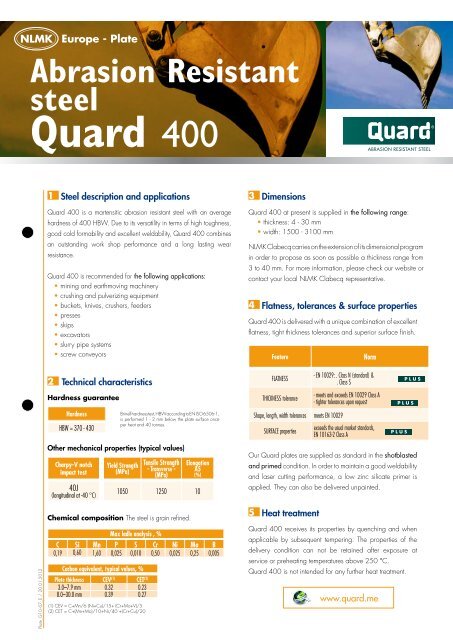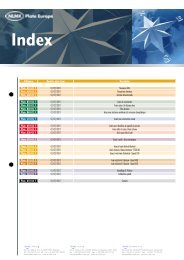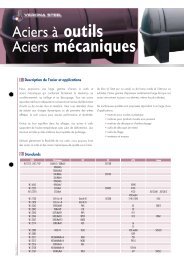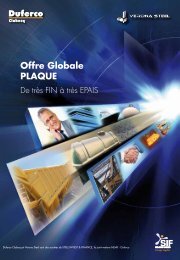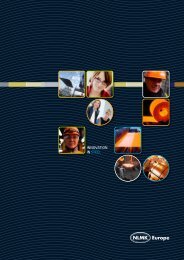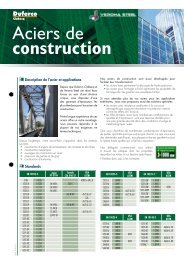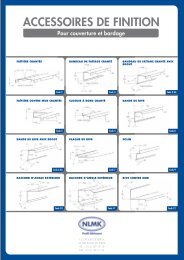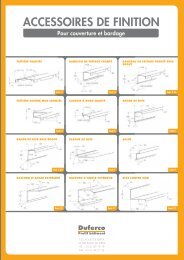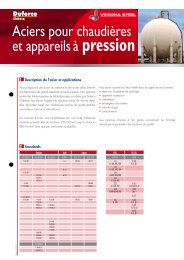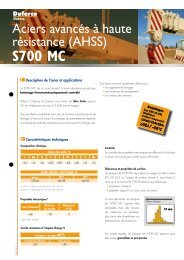Quard 400 - NLMK Europe
Quard 400 - NLMK Europe
Quard 400 - NLMK Europe
You also want an ePaper? Increase the reach of your titles
YUMPU automatically turns print PDFs into web optimized ePapers that Google loves.
<strong>Europe</strong> - Plate<br />
Abrasion Resistant<br />
steel<br />
<strong>Quard</strong> <strong>400</strong><br />
1 Steel description and applications<br />
<strong>Quard</strong> <strong>400</strong> is a martensitic abrasion resistant steel with an average<br />
hardness of <strong>400</strong> HBW. Due to its versatility in terms of high toughness,<br />
good cold formability and excellent weldability, <strong>Quard</strong> <strong>400</strong> combines<br />
an outstanding work shop performance and a long lasting wear<br />
resistance.<br />
<strong>Quard</strong> <strong>400</strong> is recommended for the following applications:<br />
• mining and earthmoving machinery<br />
• crushing and pulverizing equipment<br />
• buckets, knives, crushers, feeders<br />
• presses<br />
• skips<br />
• excavators<br />
• slurry pipe systems<br />
• screw conveyors<br />
3 Dimensions<br />
<strong>Quard</strong> <strong>400</strong> at present is supplied in the following range:<br />
• thickness: 4 - 30 mm<br />
• width: 1500 - 3100 mm<br />
<strong>NLMK</strong> Clabecq carries on the extension of its dimensional program<br />
in order to propose as soon as possible a thickness range from<br />
3 to 40 mm. For more information, please check our website or<br />
contact your local <strong>NLMK</strong> Clabecq representative.<br />
4 Flatness, tolerances & surface properties<br />
<strong>Quard</strong> <strong>400</strong> is delivered with a unique combination of excellent<br />
flatness, tight thickness tolerances and superior surface finish.<br />
Feature<br />
Norm<br />
2<br />
Technical characteristics<br />
Hardness guarantee<br />
Hardness<br />
HBW = 370 - 430<br />
Brinell hardness test, HBW according to EN ISO 6506-1,<br />
is performed 1 - 2 mm below the plate surface once<br />
per heat and 40 tonnes.<br />
FLATNESS<br />
THICKNESS tolerance<br />
Shape, length, width tolerances meets EN 10029<br />
SURFACE properties<br />
- EN 10029: . Class N (standard) &<br />
. Class S<br />
- meets and exceeds EN 10029 Class A<br />
- tighter tolerances upon request<br />
exceeds the usual market standards,<br />
EN 10163-2 Class A<br />
P L U S<br />
P L U S<br />
P L U S<br />
Other mechanical properties (typical values)<br />
Charpy-V notch<br />
impact test<br />
40J<br />
(longitudinal at -40 °C)<br />
Yield Strength<br />
(MPa)<br />
Tensile Strength<br />
- Transverse -<br />
(MPa)<br />
Elongation<br />
A5<br />
(%)<br />
1050 1250 10<br />
Our <strong>Quard</strong> plates are supplied as standard in the shotblasted<br />
and primed condition. In order to maintain a good weldability<br />
and laser cutting performance, a low zinc silicate primer is<br />
applied. They can also be delivered unpainted.<br />
Plate_G10--07_E / 20.01.2012<br />
Chemical composition The steel is grain refined.<br />
Max ladle analysis , %<br />
C Si Mn P S Cr Ni Mo B<br />
0,19 0,60 1,60 0,025 0,010 0,50 0,025 0,25 0,005<br />
Carbon equivalent, typical values, %<br />
Plate thickness CEV (1) CET (2)<br />
3.0–7.9 mm 0.32 0.23<br />
8.0–30.0 mm 0.39 0.27<br />
(1) CEV = C+Mn/6 (Ni+Cu)/15+ (Cr+Mo+V)/5<br />
(2) CET = C+(Mn+Mo)/10+Ni/40 +(Cr+Cu)/20<br />
5 Heat treatment<br />
<strong>Quard</strong> <strong>400</strong> receives its properties by quenching and when<br />
applicable by subsequent tempering. The properties of the<br />
delivery condition can not be retained after exposure at<br />
service or preheating temperatures above 250 °C.<br />
<strong>Quard</strong> <strong>400</strong> is not intended for any further heat treatment.<br />
www.quard.me
<strong>Europe</strong> - Plate<br />
7 Ultrasonic testing<br />
Ultrasonic testing (UT) is used to detect any defect in the<br />
plate like cracks or porosity. In thickness from 8 mm, all<br />
<strong>Quard</strong> plates are UT tested and delivered in class S2/E2,<br />
according to EN 10160.<br />
8 General processing recommendations<br />
To obtain optimal work shop productivity when processing<br />
<strong>Quard</strong> <strong>400</strong>, it is essential to use the recommended procedures<br />
and tools given below.<br />
Thermal cutting<br />
Plasma and flame cutting can be performed without the need for<br />
preheating in thicknesses up to 40 mm, provided the ambient<br />
temperature is above 0 °C.<br />
Subsequent to cutting, let the cut parts slowly cool down to room<br />
temperature. A slow cooling rate will reduce the risk of cut edge<br />
cracking (never accelerate the cooling of the parts).<br />
Cold forming<br />
<strong>Quard</strong> <strong>400</strong> is very well suited for cold forming operations.<br />
The minimum recommended R/t ratio when bending of <strong>Quard</strong><br />
<strong>400</strong> is given in the table below:<br />
Welding<br />
<strong>Quard</strong> <strong>400</strong> has a very good weldability, granted by the low<br />
carbon equivalent of the steel. It can be welded using any of the<br />
conventional welding methods, both as manual or automatic.<br />
Welding of <strong>Quard</strong> is recommended to be performed at ambient<br />
temperature not lower than +5°C. Subsequent to welding, let<br />
the welded parts slowly cool down to room temperature (never<br />
accelerate the cooling process of the weld).<br />
If welding using a heat input of 1.7 kJ/mm, preheating is not<br />
required in single plate thickness up to 20 mm. The interpass<br />
temperature used should not exceed 225 °C.<br />
Soft weld consumables, giving low hydrogen weld deposits<br />
(


